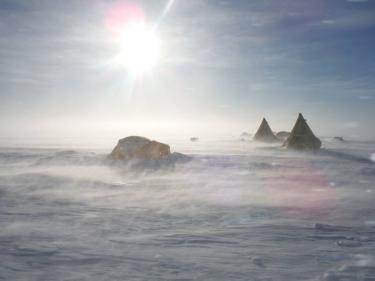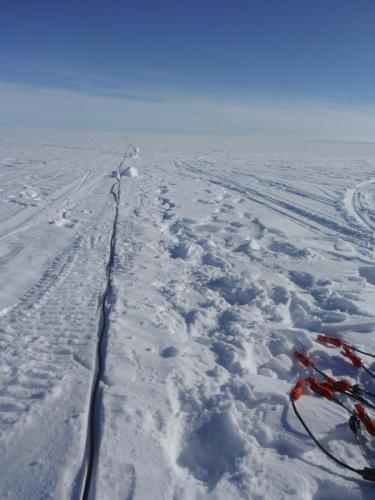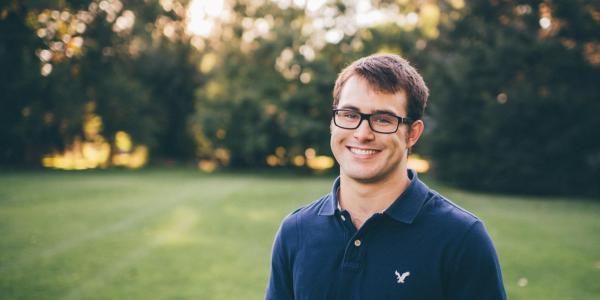Dynamic grad student uses explosives to map Antarctic ice shelves
University of Colorado Boulder alumna Jade Cooley begins her science talks to students throughout Washington by saying, “My name is Jade, and I once set off explosives in Antarctica for science. Now I’m going to tell you about glaciology.”
Funded by a POLENET grant, Cooley (Physics 2011) spent six weeks conducting research and camping on Antarctica’s Ross Ice Shelf last November.
Cooley, who will graduate next June with a master’s degree in geology from Central Washington University, credits CU Boulder for where she is today.
“CU [Boulder] has a really excellent physics program, and I’m grateful to its professors,” Cooley says, acknowledging that her familiarity with certain physics concepts ,especially programming, as incredibly useful in understanding what's going on in the ice sheets.
Initially, Cooley wasn’t sure what to do with her physics degree. She considered going into quantum physics, but “it wasn't hitting the issues that I feel are really societally relevant, like climate change,” she says.
So she got in touch with Anne Sheehan, professor of geophysics at CU Boulder. Sheehan welcomed Cooley to audit her class and helped Cooley find her CWU advisor, Paul Winberry, and his fieldwork in Antarctica.
Cooley’s research group camped on the Crary Ice Rise, 400 miles from Antarctica’s McMurdo Station. The Crary Ice Rise is a slowly moving feature of the Ross Ice Shelf. Ice shelves transport ice from the continent onto the ocean, where it displaces seawater and increases already-rising sea levels.
Camping in Antarctica can give researchers plenty of time to reflect on isolation and the colorless landscape.
The research involved conducting active seismic surveys by setting off explosives in the ice. Because there is a noticeable difference in seismic activity when ice, compared to rock, is disturbed, this will allow Winberry and Cooley to map the currently unknown ice and bedrock composition throughout the Crary Ice Rise.
“This will tell the story of historic climate shifts… and help us predict the impact of the earth’s current warming trends,” Cooley says. It may also show whether Crary Ice Rise will be deposited into the sea.
The only first-timer, only master’s student and only female in the six-person research team, Cooley learned glaciology firsthand, drove a snowmobile and honed her snow-shoveling and snow-sculpting abilities.
Active seismic surveys require all-day digging to bury and uncover the geophones that record seismic activity. And each time there was a severe storm day, Cooley dug and carved herself a new, elaborate bathroom with a shovel and ice saw.
She also had plenty of time to reflect on the isolation and bleak landscape. She observed that the only real color or sounds came from manmade things.
“Yes, the wind made noise, but that noise came from the tent flapping in the wind or the wind blowing in your ear. And the only snow skittering across the ice was what we unearthed with our footprints or snowmobile,” Cooley says.
The constant sunlight and flat tundra affected the scientists’ spatial perception. While setting up a straight 12-kilometer line of flags for the seismic survey site, Cooley “had a gut feeling that we were slowly curving off to the right, but when I looked behind me I could see that [the survey flags] were in a straight line.”
She realized her perception was skewed because there was nothing to orient her in the white, flat landscape; instead, she was orienting herself to the sun, which had slowly shifted left.
Living in Antarctica, even for a short period, is “a lesson in dichotomies,” Cooley says. “It’s extremely open yet very claustrophobic. Despite having no other living thing in a 100-mile radius other than your group, you are never more than 20 feet from another person.”
The landscape’s indifference to humans also struck Cooley.
“It’s not that the land is out to get people. It doesn't even care that you're there,” she says. “It will just freeze you to death and cover your bones with snow.”
On storm days, inside her violently shaking tent, Cooley dove into her supply of books “about happy, green things” that reminded her of home. She reread The Lord of the Rings, because “it’s a habit of mine to read epic stories when I visit someplace epic.”
Eventually Cooley learned to sleep despite the constant sunlight and howling winds.
As the field season wore on, the thawing Antarctic summer slightly softened the rigors of camping. Sometimes Cooley and the other researchers could even hang out inside their tents with their socks off.
On their last day, waiting for the plane back to base, “We all pulled our chairs outside, and I played a guitar while everyone read their books,” Cooley says.
She is almost nostalgic about the small, unexpected human things like this: she experienced luxury in a few bags of Cheetos, a Thanksgiving card delivered by plane from McMurdo Station, and the cake they cooked for Winberry’s birthday in their tiny camp kitchen.
Perhaps due to sensory deprivation or because of Cooley’s observant mind, she vividly recalls the quirks of Antarctica itself: snow dry as Styrofoam yielding snowmen only five inches tall; how everything, even the scientists’ knees, steamed and how that steam moves in interesting ways; their drinking water, dug up and melted daily, that tasted of “nothing but the slight tang of iron from the shovel.”
Under the Antarctic sea ice, this image of brinicle (frozen brine stuck to the ice) under the ice was taken through the Observation Tube (ObTube) at McMurdo Station.
Cooley plans to pursue a PhD, possibly in interactions between glaciers and volcanoes.
“The dream is to study in Norway. I would like to pick one or two glaciers in Norway and use different remote-sensing techniques and really get to know them well,” she says.
Returning to the land of the living was also a strange experience.
After the dearth of sounds and smells in Antarctica, the overwhelming smell of flowers upon landing in verdant Christchurch, New Zealand, made her giddy.
“The color green and feeling of warm air on my skin and sight of golden sunlight filtering through the green leaves was shocking,” Cooley says.
Once at home, she found that she missed Antarctica, though she could not articulate why.
“It’s not necessarily the best time while you’re there, but you do a whole lot of hard work and it’s a really unique, worthwhile experience. Life there is really simple, and you come back with a new appreciation for things you didn’t notice before.”







